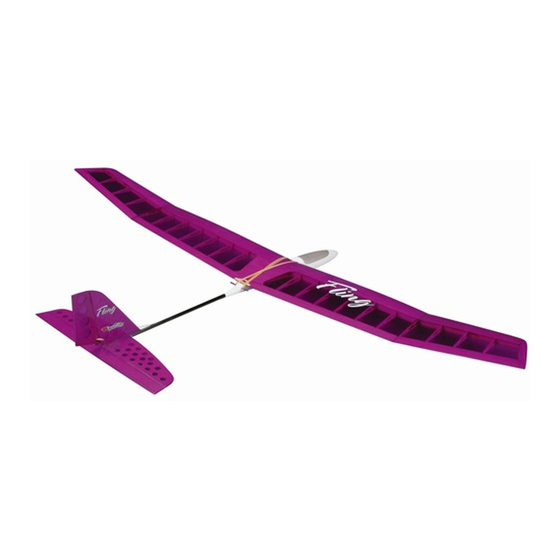GREAT PLANES FLING Manual de instruções - Página 11
Procurar online ou descarregar pdf Manual de instruções para Brinquedo GREAT PLANES FLING. GREAT PLANES FLING 16 páginas. Fling arf

CAUTION (THIS APPLIES TO ALL R/C AIRPLANES): If,
while flying, you notice an alarming or unusual sound
such as a low-pitched "buzz," this may indicate control
surface flutter . Flutter occurs when a control surface
(such as an aileron or elevator) or a flying surface (such
as a wing or stab) rapidly vibrates up and down (thus
causing the noise). In extreme cases, if not detected
immediately, flutter can actually cause the control surface
to detach or the flying surface to fail, thus causing loss of
control followed by an impending crash. The best thing to
do when flutter is detected is to slow the model
immediately, then land as soon as safely possible.
Identify which surface fluttered (so the problem may be
resolved) by checking all the servo grommets for
deterioration or signs of vibration. Make certain all
pushrod linkages are secure and free of play. If it fluttered
once, under similar circumstances it will probably flutter
again unless the problem is fixed. Some things which can
cause flutter are; Excessive hinge gap; Not mounting
control horns solidly; Excessive free play in servo gears;
Insecure servo mounting.
Preparations
First of all, if you are flying with other flyers, check to
make sure they are not flying or testing on the same
frequency as your model. Try to find an experienced
pilot to help you with your first flights. Although the Fling
ARF is very easy to fly, an experienced pilot can save you a
lot of time and possible aggravation by helping you get your
model in the air smoothly.
Find a BIG, OPEN field for your first flights – the bigger the
better as you won't have to worry about where you need to
land. Ground based objects (trees, poles, buildings, etc.)
seem to attract model airplanes like a magnet.
Trim Flights
It is a good idea to do a couple of trim flights before each
flying session to make sure the plane is still in trim and the
radio is working properly. The model will survive a hard
FLYING
landing from 6 feet [2M] much better than it will one from
several hundred feet. The first few trim flights should be
done over a grass field. The longer the grass, the better
(more cushion). Turn on the transmitter first and then the
receiver. Hold the Fling ARF under the wing with the nose
pointed slightly down and directly into the wind as shown in
the photo. It is very important that you launch the model with
the wings level and the nose pointing at a spot on the
ground about 50 feet in front of you. Have a friend stand off
to the side of you and tell you whether the nose is pointing
up or down. Show your friend the preceding picture so he
will know what to look for. If the sailplane is launched with
the nose up or launched too hard it will climb a few feet, stall
and fall nose-first straight down. With the nose pointed down
slightly, the sailplane will accelerate down until it picks up
enough flying speed and then level off and glide forward.
The plane should be launched with a gentle push forward.
With a little practice you will be able to launch it at just the
right speed so it soars straight ahead in a long and
impressive glide path. Adjust the trims on your transmitter to
get the plane to fly straight ahead in a smooth glide path.
Once you get the hang of launching, you can try turning the
plane during the trim flights by gently applying a "touch" of
right or left rudder. You can also try "flaring" the landings by
slowly applying a touch of up elevator (pull the stick back) as
the plane nears the ground. The Fling ARF will continue to
fly just a few inches off the ground for a surprisingly long
distance. It is important you don't "over-control" the model.
Make any control inputs slowly and smoothly rather than
moving the transmitter sticks abruptly.
First Flights
Note: Remember that your radio control responds as if
you were sitting in the cockpit. When you push the
transmitter stick to the right, the rudder moves to the
plane's right! This means that when the plane is flying
towards you it may seem like the rudder controls are
reversed (when you give "right" rudder the plane turns
to your left–which is the plane's "right"). It is sometimes
easier to learn to fly the plane if you always face your body
in the direction the plane is flying and look over your
shoulder to watch the model.
Don't worry about accomplishing very much on your first
flights. Use these flights to get the "feel" of the controls and
the Fling's flying characteristics. Try to keep the plane
upwind and just perform some gentle "S-turns" (always
turning into the wind) until it is time to set up for landing.
Have a helper adjust the trims on your transmitter (a little at
a time) until the plane will fly straight and level with the
transmitter sticks in their neutral positions. It can be very
hard for a beginner to fly a plane straight towards him as he
would have to do if the plane were downwind and every
mistake took the plane a little farther downwind. When it is
time to land, just continue performing the gentle "S-turns"
upwind and let the plane glide onto the ground. Don't worry
about where the plane lands–just miss any trees, etc.
11
